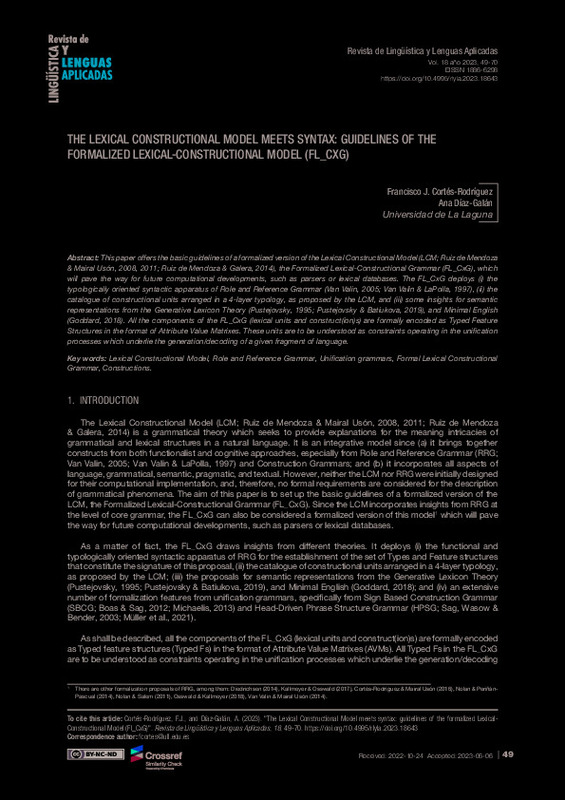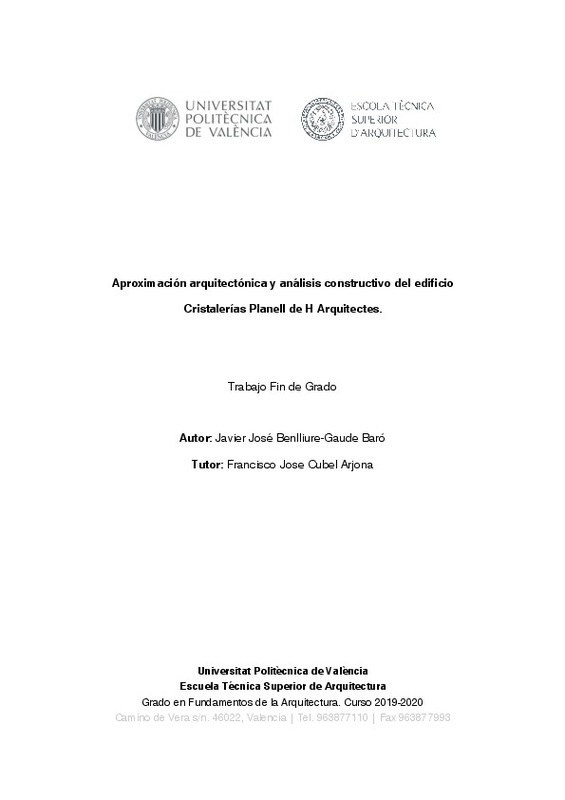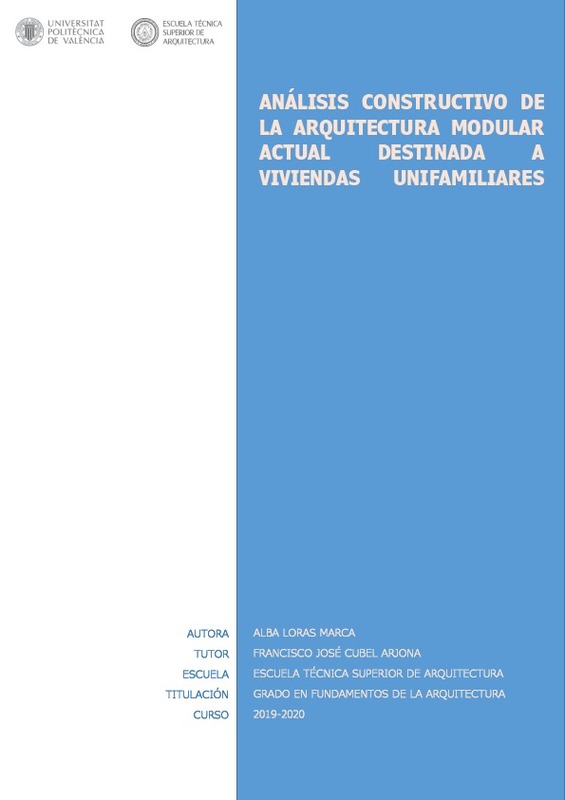JavaScript is disabled for your browser. Some features of this site may not work without it.
Buscar en RiuNet
Listar
Mi cuenta
Estadísticas
Ayuda RiuNet
Admin. UPV
The lexical constructional model meets syntax: guidelines of the formalized lexical-constructional model (FL_CxG )
Mostrar el registro sencillo del ítem
Ficheros en el ítem
| dc.contributor.author | Cortés-Rodríguez, Francisco José
|
es_ES |
| dc.contributor.author | Díaz-Galán, Ana
|
es_ES |
| dc.date.accessioned | 2023-10-17T19:28:26Z | |
| dc.date.available | 2023-10-17T19:28:26Z | |
| dc.date.issued | 2023-07-26 | |
| dc.identifier.issn | 1886-2438 | |
| dc.identifier.uri | http://hdl.handle.net/10251/198260 | |
| dc.description.abstract | [EN] This paper offers the basic guidelines of a formalized version of the Lexical Constructional Model (LCM; Ruiz de Mendoza & Mairal Usón, 2008, 2011; Ruiz de Mendoza & Galera, 2014), the Formalized Lexical-Constructional Grammar (FL_CxG), which will pave the way for future computational developments, such as parsers or lexical databases. The FL_CxG deploys (i) the typologically oriented syntactic apparatus of Role and Reference Grammar (Van Valin, 2005; Van Valin & LaPolla, 1997), (ii) the catalogue of constructional units arranged in a 4-layer typology, as proposed by the LCM, and (iii) some insights for semantic representations from the Generative Lexicon Theory (Pustejovsky, 1995; Pustejovsky & Batiukova, 2019), and Minimal English (Goddard, 2018). All the components of the FL_CxG (lexical units and construct(ion)s) are formally encoded as Typed Feature Structures in the format of Attribute Value Matrixes. These units are to be understood as constraints operating in the unification processes which underlie the generation/decoding of a given fragment of language. | es_ES |
| dc.description.abstract | [ES] Este trabajo ofrece las directrices básicas de una versión formalizada del Modelo Léxico Construccional (MCL; Ruiz de Mendoza & Mairal Usón, 2008, 2011; Ruiz de Mendoza & Galera, 2014), la Gramática Léxico-Construccional Formalizada (FL_CxG), que allanará el camino para futuros desarrollos computacionales, como analizadores sintácticos o bases de datos léxicas. La FL_CxG despliega (i) el aparato sintáctico orientado tipológicamente de la Gramática de Roles y Referencias (Van Valin, 2005; Van Valin & LaPolla, 1997), (ii) el catálogo de unidades constructivas ordenadas en una tipología de 4 capas, como propone la LCM, y (iii) algunas ideas para las representaciones semánticas de la Teoría del Léxico Generativo (Pustejovsky, 1995; Pustejovsky & Batiukova, 2019), y el Inglés Mínimo (Goddard, 2018). Todos los componentes del FL_CxG (unidades léxicas y construct(ion)s) se codifican formalmente como Estructuras de Características Tipificadas en el formato de Matrices de Valores de Atributos. Estas unidades deben entenderse como restricciones que operan en los procesos de unificación que subyacen a la generación/decodificación de un fragmento dado de la lengua. | es_ES |
| dc.language | Inglés | es_ES |
| dc.publisher | Universitat Politècnica de València | es_ES |
| dc.relation.ispartof | Revista de Lingüística y Lenguas Aplicadas | es_ES |
| dc.rights | Reconocimiento - No comercial - Sin obra derivada (by-nc-nd) | es_ES |
| dc.subject | Modelo de construcción léxica | es_ES |
| dc.subject | Gramática de roles y referencias | es_ES |
| dc.subject | Gramáticas de unificación | es_ES |
| dc.subject | Gramática léxica construccional formal | es_ES |
| dc.subject | Construcciones gramaticales | es_ES |
| dc.subject | Lexical Constructional Model | es_ES |
| dc.subject | Role and Reference Grammar | es_ES |
| dc.subject | Unification grammars | es_ES |
| dc.subject | Formal Lexical Constructional Grammar | es_ES |
| dc.subject | Constructions | es_ES |
| dc.title | The lexical constructional model meets syntax: guidelines of the formalized lexical-constructional model (FL_CxG ) | es_ES |
| dc.type | Artículo | es_ES |
| dc.identifier.doi | 10.4995/rlyla.2023.18643 | |
| dc.rights.accessRights | Abierto | es_ES |
| dc.description.bibliographicCitation | Cortés-Rodríguez, FJ.; Díaz-Galán, A. (2023). The lexical constructional model meets syntax: guidelines of the formalized lexical-constructional model (FL_CxG ). Revista de Lingüística y Lenguas Aplicadas. 18:49-70. https://doi.org/10.4995/rlyla.2023.18643 | es_ES |
| dc.description.accrualMethod | OJS | es_ES |
| dc.relation.publisherversion | https://doi.org/10.4995/rlyla.2023.18643 | es_ES |
| dc.description.upvformatpinicio | 49 | es_ES |
| dc.description.upvformatpfin | 70 | es_ES |
| dc.type.version | info:eu-repo/semantics/publishedVersion | es_ES |
| dc.description.volume | 18 | es_ES |
| dc.identifier.eissn | 1886-6298 | |
| dc.relation.pasarela | OJS\18643 | es_ES |
| dc.description.references | Abeillé, A. & Borsley, R.D. (2021). "Basic properties and elements", in S. Müller, A. Abeillé, R.D. Borsley & J.P. Koenig (eds.) Head-Driven Phrase Structure Grammar. The Handbook. Berlin: Language Science Press, 3-46. | es_ES |
| dc.description.references | Boas, H.C., & Sag, I. (Eds.). (2012). Sign-Based Construction Grammar. Stanford: CSLI | es_ES |
| dc.description.references | Cortés-Rodríguez, F.J. (2009). "The Inchoative Construction: Semantic Representation and Unification Constraints", in C. Butler & J. Martín Arista, (eds.) Deconstructing Constructions. Amsterdam: John Benjamins, 247-270. https://doi.org/10.1075/slcs.107.10the | es_ES |
| dc.description.references | Cortés-Rodríguez, F.J. (2021). "La Gramática Formalizada Léxico-Construccional: aspectos generales", in Herrera Santana, J. & A. Díaz-Galán (eds.) Aportaciones al estudio de las lenguas. Perspectivas teóricas y aplicadas. Berlin: Peter Lang, 91-108. | es_ES |
| dc.description.references | Cortés-Rodríguez, F.J. & Mairal Usón, R. (2013). Constraints on English Middle Structures: A Lexical-Constructional Analysis. Onomázein, 27, 220-224. https://doi.org/10.7764/onomazein.27.15 | es_ES |
| dc.description.references | Cortés-Rodríguez, F.J. & Mairal Usón, R. (2016). Building an RRG computational grammar. Onomázein, 34, 86-117. https://doi.org/10.7764/onomazein.34.22 | es_ES |
| dc.description.references | Croft, W. (2001). Radical Construction Grammar: Syntactic Theory in Typological Perspective. Oxford: Oxford University Press. https://doi.org/10.1093/acprof:oso/9780198299554.001.0001 | es_ES |
| dc.description.references | Croft, W. (2012). Verbs: Aspect and Causal Structure. Oxford: Oxford University Press. https://doi.org/10.1093/acprof:oso/9780199248582.001.0001 | es_ES |
| dc.description.references | Diedrichsen, E. (2014). "A Role and Reference Grammar Parser for German", in B. Nolan & C. Periñán-Pascual (eds.) Language Processing and Grammars Amsterdam/Philadelphia: John Benjamins, 105-142. https://doi.org/10.1075/slcs.150.05die | es_ES |
| dc.description.references | Dowty, D. (2001). "The semantic asymmetry of 'argument alternations' (and why it matters)", in G. van der Meer & A. G.B. ter Meulen (eds.) Arbeiten zur Germanistischen Linguistik 44. Groningen: Center for Language and Cognition Groningen, 171-186. http://www.ling.ohio-state.edu/~dowty [retrieved: 9.06.22] | es_ES |
| dc.description.references | Faber, P., & Mairal Usón, R. 1999. Constructing a Lexicon of English Verbs. Berlin: Mouton. https://doi.org/10.1515/9783110800623 | es_ES |
| dc.description.references | Goddard, C. (Ed.). (2018). Minimal English for a Global World. Improve Communication Using Fewer Words. London: Palgrave McMillan. https://doi.org/10.1007/978-3-319-62512-6 | es_ES |
| dc.description.references | Goddard, C. & Wierzbicka, A. (Eds.). (2002). Meaning and Universal Grammar. Amsterdam: John Benjamins. https://doi.org/10.1075/slcs.60 | es_ES |
| dc.description.references | Goddard, C. & Wierzbicka, A. (Eds). (1994). Semantic and Lexical Universals. Amsterdam: Benjamins. https://doi.org/10.1075/slcs.25 | es_ES |
| dc.description.references | Goldberg, A. (1995). Constructions: A construction grammar approach to argument structure. Chicago: University of Chicago Press. | es_ES |
| dc.description.references | Goldberg, A. (2006). Constructions at work: The nature of generalization in language. Oxford: Oxford University Press. https://doi.org/10.1093/acprof:oso/9780199268511.001.0001 | es_ES |
| dc.description.references | Kallmeyer, L., & Osswald, R. (2017). "Combining Predicate-Argument Structure and Operator Projection: Clause Structure in Role and Reference Grammar", in Proceedings of the 13th International Workshop on Tree Adjoining Grammars and Related Formalisms (TAG+13). Umea, Sweden: Association for Computational Linguistics, 61-70. | es_ES |
| dc.description.references | Langacker, R. (2005). "Construction Grammars: Cognitive, Radical, and Less So", in F.J. Ruiz de Mendoza & M.S. Peña Cervel (eds.) Cognitive Linguistics: Internal Dynamics and Interdisciplinary Interaction. Berlin/New York: Mouton de Gruyter, 101-159. https://doi.org/10.1515/9783110197716.1.101 | es_ES |
| dc.description.references | Langacker, R. (2009a). Cognitive (Construction) Grammar. Cognitive Linguistics, 20, 167-176. https://doi.org/10.1515/COGL.2009.010 | es_ES |
| dc.description.references | Langacker, R. (2009b). Investigations in Cognitive Grammar. Berlin/New York: Mouton de Gruyter. https://doi.org/10.1515/9783110214369 | es_ES |
| dc.description.references | Lichte, T. & Kallmeyer, L. (2017). "Tree-Adjoining Grammar: A tree-based constructionist grammar framework for natural language understanding", in L. Steels & J. Feldman (eds.) The AAAI 2017 Spring Symposium on computational construction grammar and natural language understanding (Technical Report SS-17-02) Stanford, CA: CSLI Publications, 205-212. | es_ES |
| dc.description.references | Mairal Usón, R. & Ruiz de Mendoza, F. (2008). "Levels of description and explanation in meaning construction", in C. Butler & J. Martín-Arista (eds.) Deconstructing Constructions. Amsterdam/Philadelphia: John Benjamins, 153-198. https://doi.org/10.1075/slcs.107.08lev | es_ES |
| dc.description.references | Malouf, R. (2003). "Cooperating constructions", in E. Francis & L. Michaelis (eds.), Mismatch: Form-Function Incongruity and the Architecture of Grammar. Stanford, CA: CSLI Publications, 403-424. | es_ES |
| dc.description.references | Michaelis, L.A. (2003). "Word Meaning, Sentence Meaning, and Syntactic Meaning", in H. Cuyckens, R. Dirven & J. Taylor (eds.) Cognitive Perspectives on Lexical Semantics. Amsterdam: Mouton de Gruyter, 163-210. https://doi.org/10.1515/9783110219074.163 | es_ES |
| dc.description.references | Michaelis, L.A. (2013). "Sign-Based Construction Grammar", in T. Hoffman & G. Trousdale. (eds.) The Oxford Handbook of Construction Grammar. Oxford: Oxford University Press, 133-152. https://doi.org/10.1093/oxfordhb/9780195396683.013.0008 | es_ES |
| dc.description.references | Müller, S. (2016). Grammatical Theory: From Transformational Grammar to Constraint-based Approaches. Berlin: Language Science Press. https://doi.org/10.26530/OAPEN_611693 | es_ES |
| dc.description.references | Müller, S., Abeillé, A., Borsley, R.D., &. Koenig, J.P. (Eds.). (2021). Head-Driven Phrase Structure Grammar. The Handbook. Berlin: Language Science Press. | es_ES |
| dc.description.references | Nolan, B. & Periñán-Pascual, C. (Eds.). (2014). Language processing and grammars. Amsterdam: John Benjamins. https://doi.org/10.1075/slcs.150 | es_ES |
| dc.description.references | Nolan, B. & Salem, Y. (2011). "UniArab: RRG Arabic-to-English machine translation", in W. Nakamura (ed.) New Perspectives in Role and Reference Grammar Newcastle upon Tyne: Cambridge Scholars, 312-346. | es_ES |
| dc.description.references | Osswald, R. & Kallmeyer, L. (2018). "Towards a formalization of Role and Reference Grammar", in R. Kailuweit, L. Künkel & E. Staudinger (eds.) Applying and Expanding Role and Reference Grammar. Freiburg: FRIAS, 355-378. | es_ES |
| dc.description.references | Pollard, C. & Sag, I.A. (1994). Head-Driven Phrase Structure Grammar. Chicago, IL: University of Chicago Press. | es_ES |
| dc.description.references | Pustejovsky, J. (1995). The Generative Lexicon. Cambridge, Mass.: MIT Press. | es_ES |
| dc.description.references | Pustejovsky, J. & Batiukova, O. (2019). The Lexicon. Cambridge: Cambridge University Press. https://doi.org/10.1017/9780511982378 | es_ES |
| dc.description.references | Ruiz de Mendoza, F.J. & Galera Masegosa, A. (2014). Cognitive Modeling. A Linguistic Perspective. Amsterdam / Philadelphia: John Benjamins. https://doi.org/10.1075/hcp.45 | es_ES |
| dc.description.references | Ruiz de Mendoza, F.J. & Mairal Usón, R. (2007) The LCM. The general architecture of the model. http://www.lexicom.es/drupal/modelarchitecture [retrieved: 17.07.22]. | es_ES |
| dc.description.references | Ruiz de Mendoza, F.J. & Mairal Usón, R. (2008). Levels of description and constraining factors in meaning construction: An introduction to the Lexical Constructional Model. Folia Lingüística, 42/2, 355-400. https://doi.org/10.1515/FLIN.2008.355 | es_ES |
| dc.description.references | Ruiz de Mendoza, F.J. & Mairal Usón, R. (2011). "Constraints on syntactic alternation: lexical-constructional subsumption in the Lexical-Constructional Model", in P. Guerrero (ed.) Morphosyntactic Alternations in English. Functional and Cognitive Perspectives. Sheffield: Equinox, 62-82. | es_ES |
| dc.description.references | Sag, I., Wasow, T. & Bender, E. (2003). Syntactic Theory: Formal Introduction. Stanford: CSLI Publications. | es_ES |
| dc.description.references | Sag, I.A., Boas, H.C. & Kay, P. (2012). "Introducing Sign-Based Construction Grammar", in C. Hans, H.C. Boas & I.A. Sag (eds.) Sign-Based Construction Grammar. Stanford: CSLI Publications, 1-30. | es_ES |
| dc.description.references | Steels, L. (Ed.). (2011). Design Patterns in Fluid Construction Grammar. Amsterdam: John Benjamins. https://doi.org/10.1075/cal.11 | es_ES |
| dc.description.references | Van Trijp, R. (2013). A Comparison between Fluid Construction Grammar and Sign-Based Construction Grammar. Constructions and Frames, 5/1, 88-116. https://doi.org/10.1075/cf.5.1.04van | es_ES |
| dc.description.references | Van Valin, R. (2001). An Introduction to Syntax. Cambridge: Cambridge University Press. https://doi.org/10.1017/CBO9781139164320 | es_ES |
| dc.description.references | Van Valin, R. (2005). Exploring the Syntax-Semantics Interface. Cambridge: Cambridge University Press. https://doi.org/10.1017/CBO9780511610578 | es_ES |
| dc.description.references | Van Valin, R. & Mairal Usón, R. (2014). "Interfacing the Lexicon and an Ontology in a Linking Algorithm", in Gómez, M.A., Ruiz de Mendoza, F., & F. Gonzálvez-García (eds.) Theory and Practice in Functional-Cognitive Space. Amsterdam: John Benjamins, 205-228. https://doi.org/10.1075/sfsl.68.09val | es_ES |
| dc.description.references | Van Valin, R. & LaPolla, R. (1997). Syntax. Structure, meaning and function. Cambridge: Cambridge University Press. https://doi.org/10.1017/CBO9781139166799 | es_ES |
| dc.description.references | Vendler, Z. (1957 [1967]). Verbs and Times. Philosophical Review 56 143-160. [Reprinted as Chapter 4 in Linguistics in Philosophy 1967, 97-121. | es_ES |
| dc.description.references | Wierzbicka, A. (1996). Semantics: Primes and Universals. Oxford: Oxford University Press. | es_ES |
| dc.description.references | Wierzbicka, A. (1999). Emotions across Languages and Cultures: Diversity and Universals. Cambridge: Cambridge University Press. https://doi.org/10.1017/CBO9780511521256 | es_ES |











